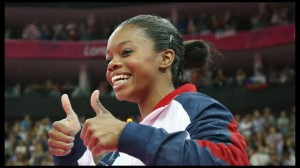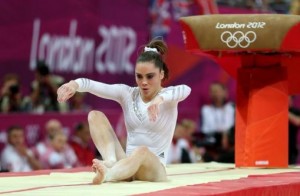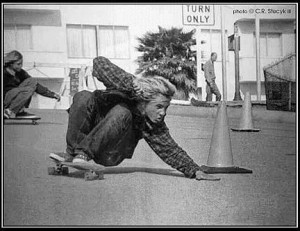The Olympics, particularly the two most popular sports from each season—the gymnastics and figure skating—sells itself, accurately, as an embodiment of competition and tension, complete with a touch of voyeurism. More, these spectacles have proven to be immune to generation or fad, as they synthesize several of America’s favorite obsessions: rivalry (friendly or not), physical prowess and especially the zero-sum proposition of win/lose. And then the added bonus that makes these events irresistible, there is the enduring possibility of abject humiliation on the largest conceivable stage.
It’s a curious ode to evolution if you think about it. What likely began as gladiatorial combat—and as stakes go, they don’t get any higher than that—gradually became uncomplicated challenges to see who could throw the farthest, run the fastest, hit the hardest. Eventually the endeavors became more complex and stylized to the point where we now have synchronized routines measured on an Aristotlean ideal that can never be attained, at least in any pure sense. We are, after all, talking about human beings engaged in activities judged by other humans. And yet that element of subjectivity is a subtle reminder of our fallibility. All the world’s a stage, let the best one win and allow us to measure the glory and the disgrace. This is what compels us to watch.
What viewer, however indifferent, is incapable of imagining the dedication and sacrifice inherent in these exhibitions? The interminable hours of practice, the inconceivable monotony of repeating the same motions days after day for months that offhandedly slip into years, sacrificing leisure and even identity for a single-minded compulsion. What is staggering about the commitment any of these sports require is that the time is not devoted merely to the pursuit of excellence; it is about being the absolute best, in the world, at something that many other people do at an impossibly high level. Consider what it must feel like to become at once smaller and larger, as a person, perfecting oneself in one specific way, while everything else in the world changes. It gets hot, and then cold, friends get fat, flunk tests, have sex, make babies, go on adventures, get married or divorced, get practiced at being imperfect and learn to speak the language of life. And you are like a monk, shrouded in the frantic sameness of actualization, repeating the same urgent prayers forever and ever until eternity…or victory.
Look at McKayla Maroney’s execution. And then consider the inexplicable fall in her individual competition. Heaven and Hell, respectively, as only the Olympics can deliver:
Then consider the art of improvisation. It is at once the epitome of skills developed through practice, and the apotheosis of the very freedom –of form, of content—that a well-rehearsed routine obviates. Put in a less pointy-headed way, a live jazz performance is exhilarating in ways that are both similar to and opposite of Olympic competition.
Old school:
New(er) school. Check out drummer Joey Baron: I’m not sure I’ve ever seen the joy and blissful abandon of improvisation so delightfully rendered.
We want to be astonished, and surprised: jazz invariably delivers. In order to play the music in the first place, sufficient mastery of the various instruments is obligatory. The practice, the woodshedding, is not dissimilar to the hours alone in a gym or a pool. In Olympic action we hope to see perfection; with jazz improvisation we want something beyond even that. We want possibility, we want to feel the kind of connections that speech and prayer and sentiment—however sincerely conveyed—cannot quite capture.
Perhaps the combination of ceaseless practice, the simple (and profound) dedication to craft, the single-minded obsession with unity of sound, is nowhere better represented than in the man who played the saxophone better than anyone has ever done anything, John Coltrane. From a piece I wrote a couple of years ago, I commented on the ways in which, even after Coltrane composed what were universally considered masterworks, he kept pushing himself. His drive was so relentless it became difficult, literally, for his audience to keep up with him:
After 1960, one can hear the imprint of Ornette Coleman alongside the harmonic algebra of Monk and Miles, all bubbling under the surface of an increasingly intense and emotional approach to songwriting (and soloing). Rashied Ali, who worked closely with Coltrane in the final years of his life, compares him to a competitive athlete: “He was like a fighter who warms up in the dressing room; he’d break a sweat (backstage)…he was always playing.” This combination of restless energy and relentless exploration led to concert experiences that were as exhausting for audiences as they were for the musicians.
And this leads me to…Jay Adams.
If you don’t know who that is, you have not seen what I consider one of the best documentaries of the last decade, Dog Town and Z-Boys.
There is an incredible sequence that would be instructive enough, if only related by the many eyewitnesses. Instead, and more than slightly miraculously—considering the time and circumstances (1975, a skateboarding competition)—it was recorded and we can actually watch it. We can see what happened as the participants reminisce about what went down that day.
It’s worth watching the entire clip (not to mention the entire movie, more of which another time—and coming soon). If you don’t want to wait, skip directly to the 45 minute mark:
To me, this remarkable moment captures, in sport and culture, a paradigm shift that echoes similar seismic changes instigated by some of our best musicians and athletes over time. But what really resonates—and I’m fairly certain this impression was facilitated by watching the Olympics these past two weeks—is that it’s difficult to imagine an event that more perfectly synthesizes the aspects of practice and improvisation: Jay Adams’s epic skate routine heard ‘round the world (or at least the underground, which is always where the magic begins) is sui generis. It’s a moment he owns, and it’s a moment that defines the skater and the sport. The sport he helped reinvent was never the same after he had his way with it. Throughout the documentary the guerilla ethos of DIY and punk rock is evoked, and there is good reason to invoke these things. On the other hand, perhaps Jay Adams was more of a jazzman than anyone ever realized.




